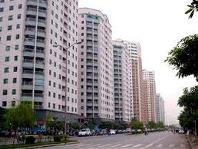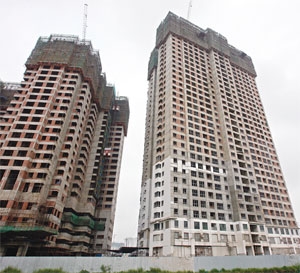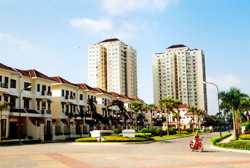No quick fix for real estate sector
No quick fix for real estate sector
A frozen real estate market and stagnant construction have caused demand for building materials to decline sharply. Producers and dealers of building materials are facing many difficulties, including mounting inventories. The director of the Ministry of Construction's Building Materials Institute, Luong Duc Long, spoke to Vietnam News Agency about the situation.
What are the difficulties facing the building materials industry?
Enterprises in the industry lack strong financial capacity. Since borrowing represents a large proportion of their total operating capital, firms are very vulnerable to fluctuations on the financial markets.
When credit is tight, they can't invest in improved production equipment so products fall behind in quality and competitiveness. Production management remains inefficient in many companies, leading to high costs and excess consumption of raw materials and energy. Demand for finished materials has also declined significantly due to stiff competition from imports, especially Chinese products.
Some say that the industry has fallen short of its potential due to inefficient planning and management. What do you think?
The Government has adopted a master plan for the nation's building materials industry and localities also have specific plans for the sector. In 2008, the Government also approved a master plan for surveying and exploiting minerals used for producing construction materials. Overall, the area's development is sufficiently planned and managed.
However, some products, such as cement, ceramic tiles and construction glass, have recently seen supplies exceed demand due to earlier, overheated investment in real estate and construction, driving enterprises, private and State-owned alike, to jump into these areas with expectations of a large market. Supplies were also driven up by the appearance of a lot of construction projects that weren't included in master plans.
But, the way I look at it, it's natural to see "hot investment" in the building industry when there's a "hot developing" economy. Viet Nam is not the only country in the region with these problems.
Thailand has a redundant cement production capacity of about 40 per cent, Japan is witnessing a 10-per-cent redundancy despite no period of "hot development", and China may face overproduction in the future since its cement industry has reached a capacity of 2.3 billion tonnes per year.
Increasing exports could help address the overcapacity, but wouldn't this conflict with the country's policy to limit exports of construction materials as mineral resources?
There are contrary opinions about this, since building materials are products that use mineral resources, consume a lot of energy, pollute the environment and generate low economic value. However, in the context of global economic integration, limiting exports creates its own set of difficulties. Exports bring about many benefits, including increased foreign currency inflows to compensate for equipment imports; reducing inventories; and enabling firms to join in the international market.
Suitable plans are needed for exports. We must select products which generate high added value and limit their quantities to perhaps 10 per cent of domestic demand. Exports can be a temporary solution for the cement industry and also a stable and long-term direction for other fields.
What steps should the industry take to ensure sustainable development?
There are seven priorities that should be immediately implemented for the industry to assure stable development in the long term: closely following master plans in investment and development; enhancing capacity and quality through technological innovation; improving management standards; selecting products with competitive advantages; actively taking part in the international market; paying attention to the environment by reducing waste; reasonably using resources; and utilising new sources of energy.
























